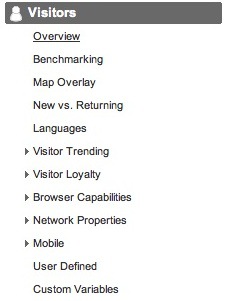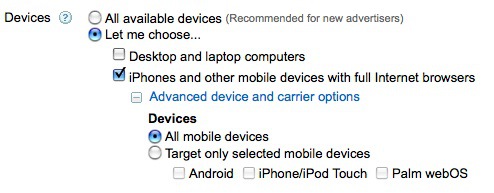Mobile search continues to explode. According to eMarketer, mobile search spending will grow 81% over the next two years. So there’s no better time to get a jump start on your mobile search campaigns. Here are 5 key steps to launching a mobile search campaign in AdWords:
1. Measure your current mobile clicks

How many of your current visitors are on mobile devices? Google recently added a mobile tab to the visitor report in Google Analytics. It tells you a) the number of mobile visitors b) their device and c) their mobile carrier. This will give a benchmark of your current stats, and give you a good idea of how mobile savvy your visitors are. If more than 5% of your visitors are on mobile devices, NOW is the time to start developing mobile-specific search campaigns.
2. Find our what your current mobile clicks are searching for
Google’s new mobile visitor reporting also tells you what keywords your mobile visitors are searching for. This data can help you craft your keyword set. How do the mobile visitors’ search queries differ from regular queries? Is their intent different? How does their interest differ from your regular keywords?
3. Craft your ads + your keywords
After you gather data on your current mobile search queries, craft your mobile-specific AdGroup. The size limit of ads for smartphone browsers (iPhone, Droid) is the same as regular “desktop” ads, but the interest and intent of your mobile visitors is going to be different than your regular browser. Google recommends keeping your keywords shorter & more generic. Your ads should reflect urgency & the short attention span of mobile visitors. For local businesses, AdWords also offers clickable phone number functionality for mobile ads, so you can catch incoming calls & measure their clicks.
 4. Optimize your landing pages for mobile devices
4. Optimize your landing pages for mobile devices
Your mobile ads need device-optimized landing pages. Start by creating mobile-optimized landing pages for the most popular device according to your device report in Google Analytics. iPhone landing pages should render for a 480 x 320 resolution, Droid landing pages should render for a 854 x 440 resolution, etc. Keep the copy simple and the call-to-actions big & bold. All the best practices of landing page optimization apply, but on a smaller scale. Also, make sure your phone number renders as text, so your visitors — whether local or nationwide — can click & call you easily.
5. Ready, set, launch!
In Google AdWords, launch your mobile-optimized campaign. Create a regular campaign, but when you get to the stage where it asks you what devices to target, select Let Me Choose > iPhones & other mobile devices with full Internet browser. AdWords also lets you drill down further & target to specific devices, including the Android, iPhone, and Palm webOS. If you want to get even more specific, you can target by carrier. I haven’t seen any differences between AT&T & Verizon users, but as your campaigns mature, you may start to notice differences.

All of the great reporting I covered in step 1 will be available for your mobile campaigns. The same rules for desktop AdWords campaigns apply — you just need to keep your mobile visitors needs in mind, and treat them separately than your desktop visitors. So start targeting campaigns for mobile, and get a head start over your competition in 2010.
Megan Leap is Marketing Manager at ion interactive, a leading provider of advanced landing page software. As Marketing Manager, Megan manages search, email, webinar, and social media campaigns. She has extensive experience in conversion rate optimization and social media marketing, and when not championing high-ROI online marketing strategies, can be found running marathons across the U.S. She is also a frequent contributor to the Post-Click Marketing Blog. Follow Megan on Twitter: @MeganLeap.




